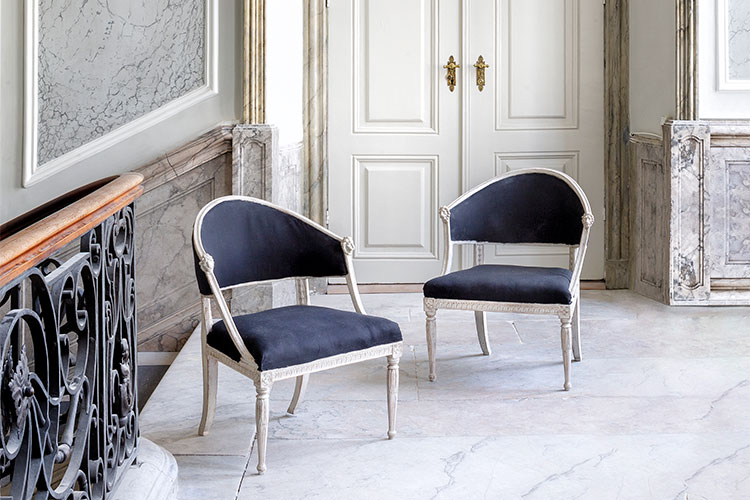Resplendent Prisms, Glorious Gustavian, and French Décor
Delve into our popular “Selected” auction, which features some stunning items for discerning collectors and quality-conscious interior design enthusiasts alike. This time, we’ll be presenting exquisite antiques, all specially selected by our experts. Everything has been made with particular finesse and bears witness to the furniture design trends across the centuries.
Resplendent Prisms
With lot number 9005 – an exceptionally fabulous vintage Louis Vuitton suitcase made of poplar wood and canvas from 1940 – we’re heading on a European voyage into the world of prism chandeliers. It takes quite the house to have one of these magnificent prism chandeliers hanging, and there’s something for every taste at “Selected” with several sizeable and very different chandeliers. The highlight of the auction is a wonderful Spanish eight-armed prism chandelier with a bronze frame, hung with cut glass beads from around 1900. The style of the characteristic Bohemian “Maria Theresia” glass chandelier with a cage-shaped frame and six candle arms originated from another part of the former Habsburg Empire, named after the Austrian Empress, the Queen of Bohemia, the only woman ruler to rule the Habsburg Empire, which she did from 1740–1780. Chandeliers like this have hung in the halls of the Hofburg in Vienna since the 18th century.
A profusion of glass and prisms can be had for living rooms of more modest ceiling height with the unusual, shortened version of the Bohemian glass chandelier from c. 1880. We then move on to a lighter, more ethereal style with the delicate Late Gustavian prism chandelier from the late 18th century – an original Swedish beauty from the time of Bellman, powdered wigs and magnificent halls adorned with silk wallpaper and bathed in golden light. The resplendent prisms represent the salon era. Back then, candles were the only way to illuminate the dark rooms, until the incredible invention of electricity opened up a bright, new world – and all the possibilities that this entailed. All created to impress and spread joy in the home.
“It’s not often that you see Spanish prism chandeliers up here in the North, while Bohemian glass is known for an age-old tradition of producing glass of extremely high quality."
Anders FredstedSpecialist in Antiques at Bruun Rasmussen
Glorious Gustavian
In Sweden, in the late 1700s, a very special “Gustavian” style was created, with pared-down furniture painted in light tones, cotton wallpapers in Swedish country style and golden, faceted mirror frames, named after the reigning king, Gustav III (1746–1792). A Francophile, the king visited France several times, introduced ice cream to Sweden and had a Danish wife who was very fond of clothes. The couple – especially the king – raised the Swedish court to new European standards with buildings and furnishings of the highest quality and the greatest of creative finesse.
The “Selected” auction features a string of Gustavian furniture such as catalogue number 9004 with unusually beautiful marquetry work in light wood, as well as two commodes which both have a “hidden” drop-down desk in the top drawer. A truly sumptuous and distinguished representative of the style is a large Gustavian console table made of gilded wood with a painted plaque. Representative of the slightly more muted, Late Gustavian style are the magnificent armchairs made of painted wood, with lion heads on the armrests and outwardly curved legs. A few Late Gustavian giltwood mirror sconces are also included in “Selected”, and very much represent the favoured, light, classicist style of the time. As we know, Gustav III’s world came to an abrupt and very dramatic end, when – fully in keeping with the “Savoir vivre” of the 1700s – he was shot during a masquerade ball at the opera in Stockholm, dressed in a masquerade costume of knitted gold. He had up to this point lived his lavish life to the full. The mastermind of the murder ended up in Copenhagen and settled at “Bakkehuset”.
|
|
French Décor
Gustav’s murder and the French Revolution, which took place concurrently, later paved the way for the so-called “Directoire”, where three “Directors” ruled the French kingdom, and fashion was dictated by “les Incroyables” (the Unbelievables), who dressed in brightly coloured coats, knickerbockers and high collars – like Søren Kierkegaard. A pair of French, gilt bronze candelabras originates from that time, and the simple, minimalist look perfectly matches a modern-day interior. One of the three consuls was Napoleon (1769–1821), who later became emperor, and the Empire style takes its name from the rule of Emperor Napoleon. “Selected” also features a pair of French Charles X commodes – a style named after the French King Charles (1757–1836) – and a Louis Philippe mantel clock, named after the last French king who reigned until 1848. With their exquisite workmanship, these somewhat robust commodes were then, as now, intended for more useful and practical storage, and will adorn any living room or bedroom.
Preview and Collection
Our “Selected” auction offers every opportunity for you to find all manner of home furnishings, something special, a treat for you and your home in the form of cupboards, consoles, chairs, sofas and mirrors. You can also bid on your very own Nike of Samothrace, a dancing Faun or French mantelpiece ornaments. Come in and discover quirky items and beautiful furniture for your home at the preview at our beautiful, new premises in Lyngby from 2 October until the day of the auction on Monday 16 October.

For further information, please contact
|
|
Anders FredstedAnders FredstedSpecialist / European Furniture & Rugs / København |

